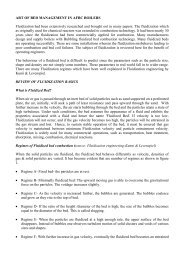Create successful ePaper yourself
Turn your PDF publications into a flip-book with our unique Google optimized e-Paper software.
<strong>Case</strong> 2 – deviation <strong>in</strong> design performance<br />
There are two APH <strong>in</strong> this boiler. One is primary<br />
APH (PAPH) and the other is secondary APH<br />
(SAPH). Both PAPH and SAPH are identical.<br />
The 3D model of PAPH / SAPH is shown <strong>in</strong><br />
picture 6. Each Airpreheater is divided <strong>in</strong> to two<br />
blocks to reduce the span of the tubes. The air<br />
from two PA fans (or SA fans) enters the blocks<br />
as separate streams but they mix at the<br />
<strong>in</strong>termediate chambers. When the APH was taken<br />
up for fluid flow <strong>studies</strong>, it was seen that there are<br />
two areas of pressure loss. They are<br />
Picture 6‐ APH model<br />
1. The air streams oppose each other and take a 180 deg turn at the <strong>in</strong>termediate ducts. Also they<br />
divide <strong>in</strong> two streams <strong>in</strong> opposite directions at the <strong>in</strong>termediate duct. There can be additional<br />
losses here.<br />
2. The air while pass<strong>in</strong>g from block 1 to block 2, goes through narrow passage created by the two<br />
stiffen<strong>in</strong>g channels of ISMC 250. See picture 7 & 8 below. Similar narrow passage is formed<br />
between block 3 & 4. The air velocity <strong>in</strong> this area is of the order of 20-24 m/s.<br />
See the detail below which expla<strong>in</strong>s the above two po<strong>in</strong>ts.<br />
Picture 7‐ APH details Picture 8 ‐<br />
APH model<br />
Simple modell<strong>in</strong>g<br />
The model had to be simplified for <strong>analysis</strong> purpose. Only one column of 22 tubes <strong>in</strong> a block is<br />
considered for <strong>analysis</strong> and flow visualisation. See picture 9 & 10. No heat flux was considered <strong>in</strong><br />
modell<strong>in</strong>g. The aim was to obta<strong>in</strong> the flow patterns and as well as flow <strong>in</strong> each tube of a block on the<br />
right side and left side. Picture 11 shows the recirculation zone due to beam stiffener.

















